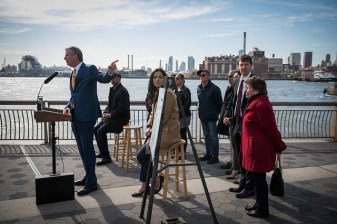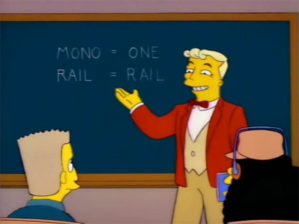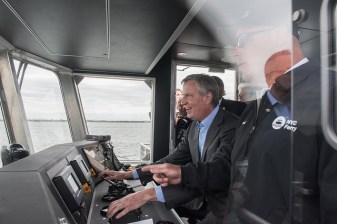Bus Rapid Transit, Not Ferry Subsidies, Would Help Struggling New Yorkers
![Image: EDC [PDF]](http://www.streetsblog.org/wp-content/uploads/2015/02/ferry_subsidy_edc.png)
In today’s State of the City address, Mayor de Blasio returned to his signature campaign issues of affordability and equity. Focusing mainly on housing, the mayor outlined a plan for growth centered around transit-accessible neighborhoods, and he recommitted to building several new Bus Rapid Transit routes.
But de Blasio missed the mark with his big new transit initiative — a subsidized ferry system. Dollar for dollar, ferries are just not an effective way to spend public money to improve transit options for low-income New Yorkers.

“If we are going to have affordable housing, how are we going to help people get around? What’s the role of transportation in making sure that people have access to opportunity and connecting to where the jobs are all over the five boroughs?” the mayor asked. “Well, we thought about that.”
De Blasio said rides on the new ferry system will cost no more than a MetroCard swipe when it launches in 2017. The system will receive $55 million from the city and serve neighborhoods including Astoria and the Rockaways in Queens, Red Hook in Brooklyn, and Soundview in the Bronx, according to DNAinfo.
“Ferries will be affordable to everyday New Yorkers, just like our subways and buses,” de Blasio said, adding that the ferries will help revitalize commercial corridors near their outer-borough landings.
This sounds great, until you look at how much ferries cost and how many people they would serve compared to better buses and trains.
Even with fares at $3.50 per ride, running ferries from Pier 11 to the Rockaways last year required a subsidy of nearly $30 per rider, according to the Economic Development Corporation. In part, that was because its limited schedule failed to attract much ridership. The more centrally-located East River Ferry has more ridership and a better schedule, but still had a slightly higher per-rider subsidy than bus service in 2013, on top of its $4 fare [PDF]. Dropping the fare to match the bus and subway would likely require additional subsidies.
Even the popular Staten Island Ferry, which is free and has frequent service, had a per-rider subsidy in 2011 more than three times higher than local MTA buses, and more than 10 times higher than the subway [PDF].
The role that ferries can play in the transportation system is limited by the accessibility of waterfront sites and the difficulty of connecting to other transit services. The East River Ferry maxed out at a daily average of 4,000 weekday riders and 6,000 weekend riders in 2013.
There’s also a disconnect between most of the areas the ferries would serve and the transit needs of low-income neighborhoods. A better way to spend those subsidies to help struggling New Yorkers would be to bolster Bus Rapid Transit improvements across the boroughs.
De Blasio did mention Bus Rapid Transit in the speech, recommitting to his campaign promise to bring the city’s BRT network to a total of 20 routes by the end of his first term. The pace of expansion will have to speed up considerably to hit that target. So far, the administration has cut the ribbon on just one new Select Bus Service route, with a handful of additional routes in the planning stages.
A coalition of groups backing expanded BRT, including the Working Families Party, the Pratt Center for Community Development, Tri-State Transportation Campaign, and Riders Alliance, issued statements thanking the mayor for commitment to BRT. City Council Transportation Committee Chair Ydanis Rodriguez also promised to hold a hearing on the future of BRT in New York and the mayor’s plans.
Other highlights from today’s speech:
- Building upon goals set out in his housing plan, the mayor called for the construction of 160,000 market rate units and 80,000 affordable units by 2024, more than doubling the average annual rate of construction over the past 25 years.
- The mayor is focused on rezoning industrial areas for residential use and identified neighborhoods for new development including the Harlem River waterfront and Jerome Avenue in the Bronx, Flushing West and Long Island City in Queens, East Harlem in Manhattan, East New York in Brooklyn, and downtown Staten Island. “We’ll create more affordable housing by literally building up, adding density to appropriate parts of our city,” de Blasio said. “We are not embarking on a mission to build towering skyscrapers where they don’t belong. We have a duty to protect and preserve the character and culture of our neighborhoods.”
- De Blasio singled out Sunnyside Yards, which he proposes decking over with 11,250 “long-term” affordable units, as a “game changer,” citing access to transportation as one of its key advantages. The project would require cooperation from Amtrak, which has expressed interest in developing above its rail facility. A spokesperson for Governor Andrew Cuomo threw cold water on the mayor’s proposal. In October, Council Member Jimmy Van Bramer said he is “opposed” to building over the yards, which he said would be “bad for the surrounding community.”
- De Blasio did not mention parking reform as a way to both reduce the cost of new construction and achieve the city’s transportation goals.
Early in the speech, de Blasio touted Vision Zero and a reduction in traffic fatalities among his first-year accomplishments but didn’t go into detail about how he will build on those gains.
“Coming off a year with record-low pedestrian fatalities, we’re pleased to hear Mayor de Blasio promise that there’s more to come on Vision Zero in 2015,” said Transportation Alternatives Executive Director Paul Steely White. “If we’re going to reach the goal of eliminating traffic fatalities and serious injuries by 2024, the city will need to go beyond 50 projects a year and transform all of the city’s dangerous arterial corridors… The mayor and the City Council must secure the funding necessary to begin work on a citywide arterial transformation plan no later than 2017.”
This post has been updated with additional information about subsidies for the East River Ferry.


